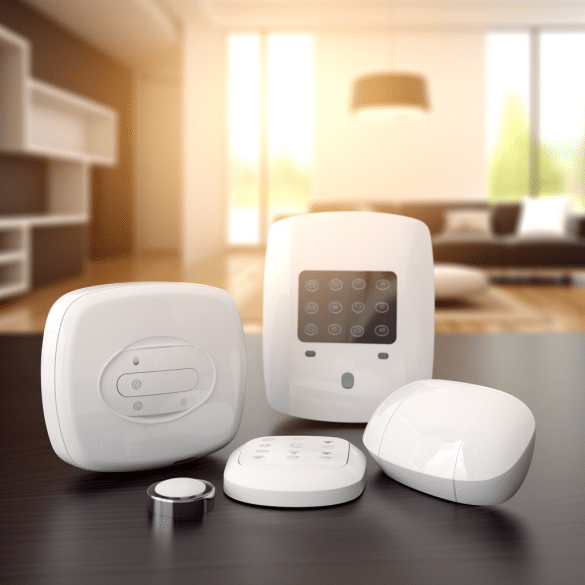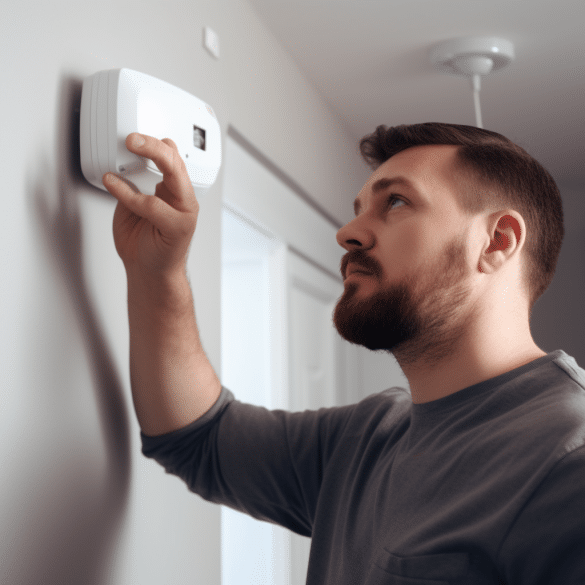As a security system professional, I am often asked about the frequency of wireless alarm systems. Understanding the different frequencies available is important when choosing the right system for your home or business. In this article, I will discuss jamming technology, manufacturing quality, superior support, NWOSS qualities, wired vs. wireless pros and cons, and how to combat RF jamming so you can make an informed decision when it comes to selecting the best system for your needs.
Wireless alarm systems have become increasingly popular in recent years due to their cost effectiveness and ease of installation compared to traditional wired systems. However, because they transmit data via radio waves instead of physical connections between components like with a wired system, there is a risk that someone could attempt to interfere with or “jam”the signal being sent by your alarm system. This is why understanding what frequency these devices use is so essential in ensuring that your alarm system remains secure and reliable.
Key Takeaways
- Wireless alarm systems use frequencies ranging from 10 kHz to 6 GHz, with the most common ones being 433 MHz and 868 MHz.
- Multiple frequencies are used to minimize interference and maximize reliability, and regularly checking frequency bands is recommended to protect against jamming attacks.
- Quality control is crucial for reliable wireless security systems, and different types of alarm systems require different levels of manufacturing quality.
- Wireless alarm systems offer increased coverage areas, remote access control, and advanced motion detection capabilities, with easy installation and no need for wired connections. However, jamming technology can disrupt the radio signals used to transmit data in wireless systems.
Jamming Technology

Jamming technology can be used to disrupt wireless alarm systems, so it’s important to know how they operate! Wireless alarm systems use radio frequencies to detect and transmit signals from one point to another. Their frequency range typically lies between 10 kHz and 6 GHz. However, the most common frequencies used are 433 MHz and 868 MHz, as these provide a better range of security. Interferences in the frequency bands may result in time lags or signal losses due to limited power or range of the radio frequency. Therefore, it is important for users of wireless security systems to ensure that their alarm system operates on the appropriate frequency band for optimal performance.
Alarms play an integral role in providing security against intruders or thefts. As such, it is vital that they have reliable communication networks using efficient frequencies that can ensure uninterrupted service. To this end, wireless alarm systems often employ multiple frequencies within their operating bandwidths to minimize interference and maximize reliability. This helps ensure that any alarms triggered will be received quickly and accurately without any data lost in transmission due to low-frequency issues.
In order to maximize protection against jamming attacks, it is recommended that wireless security system operators regularly check their system’s frequency bands for potential interferences or other anomalies before any operation takes place. Doing so will help ensure maximum performance with minimal disruptions from outside sources like jamming technology – ensuring a secure environment at all times!
Superior Support
When it comes to your security, having superior support is essential – like a set of dependable hands guiding you through the process. Wireless alarm systems have come a long way in terms of technology. They have a wide wireless range that allows for easy installation and more reliable performance. Alarm monitoring is also improved with the use of a wireless home security system, as it ensures stronger signals and better reception over larger distances than traditional hard-wired systems. RF signals are used to transmit data between the alarm system and the monitoring service, providing life-saving protection within seconds.

The radio spectrum is full of RF signals, making it difficult for some wireless alarms to receive strong enough signals from further away locations. Fortunately, advancements in technology have allowed for more powerful RF signals with longer transmission ranges – meaning even if you live in a rural area you can still benefit from reliable protection provided by your alarm system’s superior support services. This means that no matter where you are in your home or office, your wireless alarm will be able to detect any intrusions quickly and effectively thanks to its robust signal strength.
In addition to increased coverage areas, many wireless alarm systems now offer additional features such as remote access control via an app or web portal so that users can monitor their property even when they’re away from their home or business premises. This gives peace of mind knowing that everything’s safe at all times since you can take action if needed even if you’re not physically present at the location being monitored by the alarm system – allowing users to enjoy greater convenience and reliability when it comes to their safety and security needs.
Wired vs. Wireless
Comparing wired and wireless alarm systems, you’ll find that the former requires a more complex setup but offers greater reliability while the latter is simpler to install and more portable. Homeowners should consider their own needs when deciding which type of system to purchase. For those who want complete control over their security system, a wired option may be the best choice. This type of system requires installation of various electronic devices throughout the home as well as access to mains electricity for power and backup batteries in case of outages. Wireless systems use radio frequency (RF) devices instead, eliminating the need for complex wiring and allowing users to monitor their home from anywhere with an internet connection.
| WIRED | WIRELESS |
|---|---|
| More Complex Setup | Easier Installation |
| Greater Reliability | More Portable Option |
| Access to Mains Electricity Needed | Utilizes RF Devices Instead of Wiring |
| Backup Batteries Required during Outages | Monitor Home from Anywhere with Internet Connection |
It’s important for homeowners to assess what they need before making a decision about which type of alarm system is right for them. Wired systems offer greater security due to its reliable components, but it calls for electrical expertise in terms of installation. A wireless setup may be easier, but its signal can be interrupted by other RF devices, so common sense must be used when considering this option. Ultimately, both types have advantages and drawbacks that must be weighed according to individual needs before investing in either one.
Pros and Cons
Both wired and wireless alarm systems offer their own unique set of pros and cons, so it’s important to consider them carefully before making a decision.
Pros:
- Wired alarm systems are more reliable as they use cables for connection, which means signals can travel without interruption in the event of a power outage or interference from other devices. Additionally, the security channels used by wired alarm systems are also harder to penetrate than those used by wireless alarms.
- Wireless alarms on the other hand, have less cable clutter and can be installed much quicker than wired systems because there is no need to drill through walls or ceilings. They are also more discreet and since they don’t require any wiring, they can easily be moved around when needed.
Cons:
- One of the drawbacks of using a wired system is that it requires professional installation which could be quite costly depending on the complexity of the system setup. It also requires drilling holes into walls or ceilings for running cables which could lead to damage in some cases.
- Wireless alarm systems may not always be reliable due to their signal frequency being prone to interference from other devices such as microwaves, cordless phones and Bluetooth devices in close vicinity. This could lead to false alarms or missed detection if not properly configured by an expert technician.
In sum then, both types of alarm systems come with their own set of advantages and disadvantages; hence it’s best to weigh one’s options carefully before investing in either type of system – taking into account factors such as budget constraints, ease-of-installation and level of security required – so that one can make an informed decision based on individual requirements.
Combat RF Jamming
You can combat RF jamming by equipping your security setup with the right technology to protect against interference. Wireless alarm systems use radio frequencies to transmit signals and are vulnerable to disruption from RF jammers which transmit their own radio frequency signals, blocking any transmission from the wireless alarm system. To be able to counter this threat, you need a special type of technology that works specifically for this purpose.
One such technology is frequency hopping spread spectrum (FHSS), which allows devices in a network to rapidly switch frequencies up to hundreds of times per second in order to avoid potential interference or jamming attempts. By using FHSS, wireless alarm systems can stay within their allotted bandwidths while being secure from rogue signal transmissions from outside sources. Additionally, FHSS also offers improved range and better penetration through walls and other obstacles than other technologies used for short-range communications like Bluetooth or Wi-Fi
Another option is anti-jamming protocols that are designed for specific applications such as intrusion detection systems or remote control units. These protocols work by sending out multiple copies of the same message over different frequencies each time the message is sent out so that if one copy gets blocked due to interference, another copy will get through. This way, wireless alarm systems can maintain reliable communication despite any possible jamming attempts.
Frequently Asked Questions
What is the range of a wireless alarm system?
Wireless alarm systems typically operate within a range of frequencies depending on the specific type and model. Most wireless alarm systems use radio frequency, which generally runs between 300MHz and 3GHz, making them ideal for short-range communication. However, some high-end wireless alarm systems are able to reach much farther distances using ultra-high frequency (UHF) waves in the 800 MHz to 2.5 GHz range. No matter what type of system you choose, you can be sure that your wireless alarm system will provide reliable protection from potential threats.
What are the installation requirements for a wireless alarm system?
The installation requirements for a wireless alarm system vary depending on the complexity of the system. Generally, installing a wireless alarm system requires mounting and wiring sensors in appropriate locations throughout the building, programming a control unit to monitor activity, and connecting various sensors including motion detectors, door/window contacts, smoke alarms, etc. Additionally, it may be necessary to connect power sources such as batteries or external electrical systems. Professional installation is highly recommended to ensure that the alarm system is properly set up and functioning correctly.
How often should a wireless alarm system be tested for proper operation?
It is important to regularly test a wireless alarm system for proper operation in order to ensure that it is functioning correctly and providing the security you need. Depending on the type of system, testing should be conducted at least once every six months or as recommended by your alarm service provider. Testing should include checking all components of the system including sensors, detectors, control panels, and other devices to make sure they are working properly and communicating with each other effectively. If any issues are detected during testing, it is important to contact your alarm service provider right away for repair or replacement.
Conclusion
In conclusion, wireless alarm systems have both their pros and cons when it comes to security. On one hand, they are convenient and require little installation; on the other hand, they can be vulnerable to RF jamming. But with a higher quality of manufacturing and superior support from NWOSS, users can rest assured that their properties will be protected at all times. It is ironic then that some people still choose wired alarm systems instead – after all, in this day and age where technology is constantly improving, why not take full advantage of the benefits that wireless systems offer?

